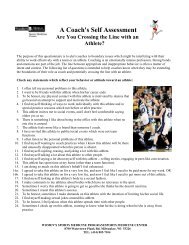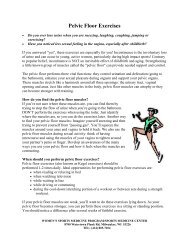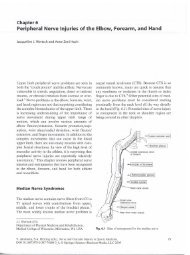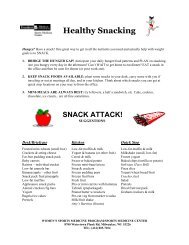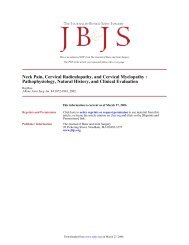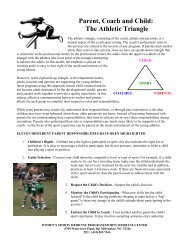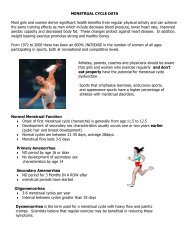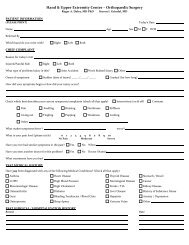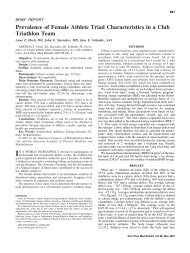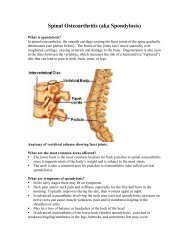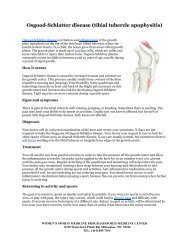Adult Acquired Flat Foot - Medical College of Wisconsin ...
Adult Acquired Flat Foot - Medical College of Wisconsin ...
Adult Acquired Flat Foot - Medical College of Wisconsin ...
Create successful ePaper yourself
Turn your PDF publications into a flip-book with our unique Google optimized e-Paper software.
Richard M. Marks, MD<br />
Pr<strong>of</strong>essor and Director<br />
Division <strong>of</strong> <strong>Foot</strong> and Ankle<br />
Department <strong>of</strong> Orthopaedic Surgery<br />
<strong>Medical</strong> <strong>College</strong> <strong>of</strong> <strong>Wisconsin</strong><br />
<strong>Adult</strong> <strong>Acquired</strong> <strong>Flat</strong> <strong>Foot</strong><br />
<strong>Adult</strong> <strong>Acquired</strong> <strong>Flat</strong>foot also referred to as Pes Planovalgus is commonly caused by<br />
dysfunction <strong>of</strong> the Posterior Tibial Tendon. This tendon is primarily responsible for<br />
maintaining the arch as well as inverting the foot. The tendon typically loses its function<br />
as a result <strong>of</strong> degenerative changes and less commonly acute rupture. Risk factors for<br />
posterior tibial tendon dysfunction include obesity, age, hypertension, diabetes, female<br />
gender, and systemic inflammatory disorders such as rheumatoid arthritis. When the<br />
tendon is dysfunctional, patients may note collapse <strong>of</strong> their arch or the foot turning<br />
outward (abduction). As the deformity progresses, patients may suffer from lateral<br />
impingement symptoms or hindfoot arthritis.<br />
If the posterior tibial tendon is actively inflammed, a course <strong>of</strong> immobilization with a<br />
boot or cast may be recommended. Other conservative treatment recommendations may<br />
include physical therapy, use <strong>of</strong> an anti-inflammatory agent, and/or orthotics. In advance<br />
cases, bracing may be necessary. When conservative means <strong>of</strong> treatment fail, surgical<br />
treatment may be considered.
Procedure: In patients with a flexible deformity and minimal arthritic changes, surgery<br />
may entail debridement and repair to the dysfunctional tendon. In some cases, a posterior<br />
tibial tendon transfer may be warranted utilizing the flexor digitorum longus (FDL)<br />
tendon. This is usually performed in combination with a corrective cut in the heel bone<br />
called a Medial Displacement Calcaneal Osteotomy to realign the heel. Not<br />
uncommonly, additional bony corrective procedures maybe necessary. These include<br />
placement <strong>of</strong> a wedged bone in the lateral aspect <strong>of</strong> the foot (lateral column lengthening,<br />
Evans osteotomy) or a medial cuneiform opening wedge osteotomy. In some cases, a<br />
subtalar implant (arthroresis) is placed to aid in correction <strong>of</strong> the deformity.<br />
Pre-Operative<br />
Post-Operative<br />
In patients with a fixed deformity or primarily arthritic complaints a Triple Arthrodesis may<br />
be performed. This entails fusing joints <strong>of</strong> the hindfoot including the Subtalar, Calcaneal-<br />
Cubiod, and Talo-Navicular joints. This may be combined with other midfoot fusions to<br />
maintain optimal alignment such as a 1 st metatarsal-cuneiform plantarflexion fusion as shown<br />
here.<br />
Pre-Operative<br />
Post-Operative<br />
Pre-Operative Considerations:<br />
All patients will have a pre-operative medical evaluation arranged either through your<br />
primary care provider or through pre-admission testing at Froedtert. Anti-inflammatory<br />
medications (i.e. ibupr<strong>of</strong>en, aspirin, plavix, or celebrex) need to be stopped seven days<br />
prior to surgery. You will be contacted the day prior to your scheduled procedure<br />
regarding the exact time <strong>of</strong> your procedure and required arrival. Please be punctual. If<br />
you are not contacted by 3:00 PM, please call (414) 805-3285 for procedures being done<br />
at Froedtert’s main OR or (414) 805-9500 for procedures at Sargent Outpatient Surgery<br />
Center.
Following surgery you will be unable to place weight on your surgical extremity thus preoperative<br />
planning is essential. Prior to surgery, an appointment with a physical therapist<br />
will be made for instructional use <strong>of</strong> crutches or a walker as their use will be required<br />
post-operatively. The device will also be fitted to your height during this appointment.<br />
The crutches or walker will be issued at that appointment or arrangements will be made<br />
to obtain the device or arrangements will be through a medical supply company approved<br />
by your insurance. Some patients may opt to use a Roll-a-bout or wheel chair. These<br />
devices can be obtained through your local medical supply store. Please contact the<br />
<strong>of</strong>fice (414-805-7442) with the medical supply store <strong>of</strong> your choice and a prescription<br />
can be faxed in. Regardless <strong>of</strong> the modality used to maintain your non-weight bearing<br />
status, please practice in your home prior to surgery as repetition will reduce the risk <strong>of</strong><br />
falls post-operatively. Removing throw rugs and clearing wider pathways through your<br />
home will also make navigating with crutches or walker easier and diminish the risk <strong>of</strong><br />
falls.<br />
During the period when strict elevation is required (the first ten days) you will need help<br />
with activities <strong>of</strong> daily living such as laundry, cooking, and cleaning. Please plan ahead<br />
and consider having friends or family stay with you. Driving is contraindicated during<br />
the acute post-operative recovery phase and may be prohibited for a longer period <strong>of</strong> time<br />
if your right foot requires immobilization. Showering will also be difficult during the<br />
recovery phase as you are unable to place weight on the surgical leg and cast/dressing<br />
needs to be kept clean and dry. Consider the use <strong>of</strong> a shower chair and/or hand held<br />
shower head. You will need to protect the leg by leaving it outside the shower as well as<br />
using bags or a plastic cast sleeve (brochure available in cast room) to ensure dressings<br />
remain dry.<br />
Postoperative Visits<br />
Day 0-10<br />
• Inpatient procedure: The procedure takes about 2-3 hours. Patients usually<br />
require a 1-2 night stay in the hospital following the procedure.<br />
• Anesthesia: This is done under a general anesthetic. A popliteal block, which<br />
injects local anesthetic behind the knee, may also be administered preoperatively<br />
to enhance post-operative pain control.<br />
• Dressings: Following the procedure, a bi-valved cast or splint will be applied to<br />
the lower leg. This dressing is to be kept clean, dry and left in place until you<br />
return to clinic.<br />
• Non-weightbearing: To ensure optimal surgical results, you will be unable to bear<br />
weight on your operative side. The use <strong>of</strong> crutches or walker is required.<br />
Activities are strictly limited during this time.<br />
• Elevation: Strict elevation above heart level (toes above the nose) for the first ten<br />
days is important to your recovery as it helps to minimize pain and swelling.<br />
Swelling can adversely affect the s<strong>of</strong>t tissue by placing increased tension on<br />
incisions putting them at increased risk for dehiscence.
• Pain Control: Pain medications will be prescribed to be used as needed. Pre-<br />
Operative nerve blocks can last between 8 to 12 hours; however, waiting to take<br />
pain medication until the block has completely worn <strong>of</strong>f can result in increased<br />
breakthrough pain which can be difficult to manage. Please plan accordingly<br />
and take your medication promptly when sensation begins to return to the foot<br />
usually indicated by a tingling sensation in the toes or mild discomfort at the<br />
surgical site. Pain medications may be taken on a scheduled basis in the early<br />
post-operative recovery phase as this is when the pain is most intense.<br />
Day 10 – First Post-Operative Visit<br />
• First postoperative visit with non-weightbearing x-rays, suture removal,<br />
application <strong>of</strong> cast.<br />
• Cast will remain on until week 6. This is necessary to allow for tendon and bony<br />
healing. Until then, cast must be kept clean, dry, and out <strong>of</strong> shower<br />
• Continue with non-weightbearing on operative leg and limited activities<br />
• May elevate extremity as needed<br />
Week 6<br />
Cast removed, weightbearing x-rays obtained, advance weightbearing in a boot from 10-<br />
100% over the next 6-8 weeks with physical therapy with appropriate restrictions.<br />
Advancement <strong>of</strong> activities may be varied based on patients’ past medical history and<br />
radiographic presentation.<br />
Week 12<br />
Weaned from boot at about week 12-14 into regular shoes with orthotics. Increase<br />
activities as tolerated. It may require 10-12 months for complete rehabilitation.<br />
Compliance with home physical therapy protocol following discharge from formal<br />
physical therapy is key to improving strengthening and endurance <strong>of</strong> the foot and ankle.<br />
Swelling can persist up to 6 – 8 months. The use <strong>of</strong> compression stockings can help<br />
diminish post-operative swelling.<br />
Scar Management: Steri-strips, which were placed over the incision following suture<br />
removal, will gradually fall <strong>of</strong>f between week 6-8. Do not pull at these; you may trim the<br />
loose edges. Once the Steri-strips have fallen <strong>of</strong>f, you may massage Vitamin E oil or<br />
Mederma into the incisions twice a day. Silicone gel strips should also be used in<br />
conjunction with the other scar management modalities. These can be obtained from the<br />
cast room.<br />
If any questions arise, please contact the <strong>of</strong>fice at (414) 805-7442 between 8:00 am and<br />
4:30 pm Monday through Friday. Leave your number and message, Dr. Marks, Jamie,<br />
his physician assistant, or Mary S., his nurse, will return your call.



